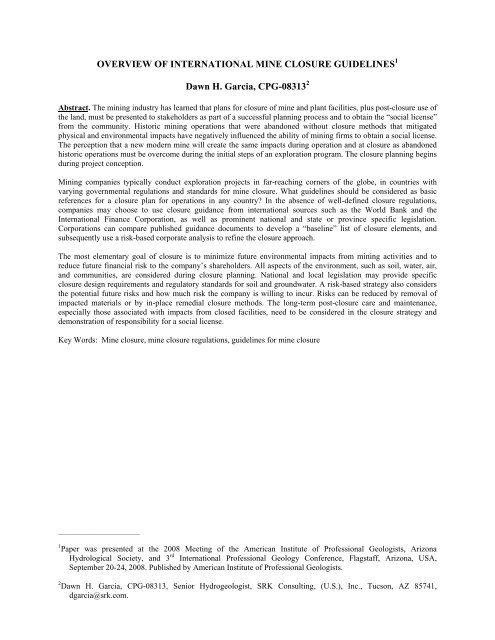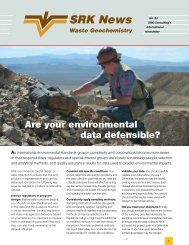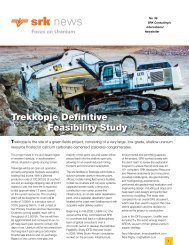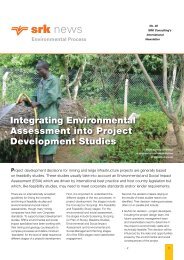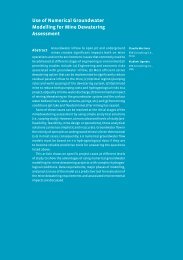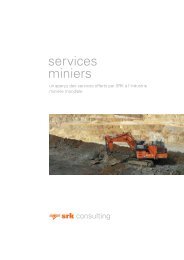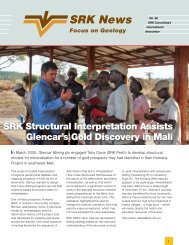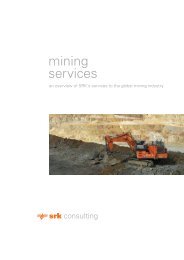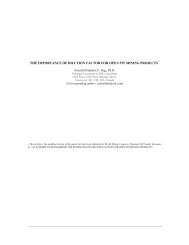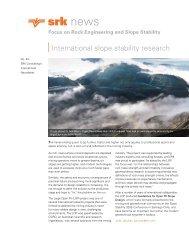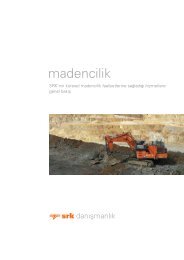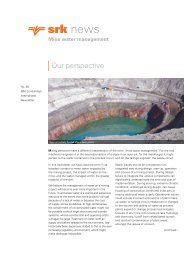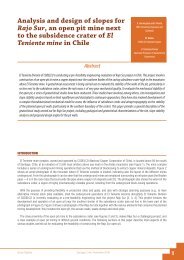OVERVIEW OF INTERNATIONAL MINE ... - SRK Consulting
OVERVIEW OF INTERNATIONAL MINE ... - SRK Consulting
OVERVIEW OF INTERNATIONAL MINE ... - SRK Consulting
Create successful ePaper yourself
Turn your PDF publications into a flip-book with our unique Google optimized e-Paper software.
<strong>OVERVIEW</strong> <strong>OF</strong> <strong>INTERNATIONAL</strong> <strong>MINE</strong> CLOSURE GUIDELINES 1Dawn H. Garcia, CPG-08313 2Abstract. The mining industry has learned that plans for closure of mine and plant facilities, plus post-closure use ofthe land, must be presented to stakeholders as part of a successful planning process and to obtain the “social license”from the community. Historic mining operations that were abandoned without closure methods that mitigatedphysical and environmental impacts have negatively influenced the ability of mining firms to obtain a social license.The perception that a new modern mine will create the same impacts during operation and at closure as abandonedhistoric operations must be overcome during the initial steps of an exploration program. The closure planning beginsduring project conception.Mining companies typically conduct exploration projects in far-reaching corners of the globe, in countries withvarying governmental regulations and standards for mine closure. What guidelines should be considered as basicreferences for a closure plan for operations in any country? In the absence of well-defined closure regulations,companies may choose to use closure guidance from international sources such as the World Bank and theInternational Finance Corporation, as well as prominent national and state or province specific legislation.Corporations can compare published guidance documents to develop a “baseline” list of closure elements, andsubsequently use a risk-based corporate analysis to refine the closure approach.The most elementary goal of closure is to minimize future environmental impacts from mining activities and toreduce future financial risk to the company’s shareholders. All aspects of the environment, such as soil, water, air,and communities, are considered during closure planning. National and local legislation may provide specificclosure design requirements and regulatory standards for soil and groundwater. A risk-based strategy also considersthe potential future risks and how much risk the company is willing to incur. Risks can be reduced by removal ofimpacted materials or by in-place remedial closure methods. The long-term post-closure care and maintenance,especially those associated with impacts from closed facilities, need to be considered in the closure strategy anddemonstration of responsibility for a social license.Key Words: Mine closure, mine closure regulations, guidelines for mine closure_______________________________1 Paper was presented at the 2008 Meeting of the American Institute of Professional Geologists, ArizonaHydrological Society, and 3 rd International Professional Geology Conference, Flagstaff, Arizona, USA,September 20-24, 2008. Published by American Institute of Professional Geologists.2 Dawn H. Garcia, CPG-08313, Senior Hydrogeologist, <strong>SRK</strong> <strong>Consulting</strong>, (U.S.), Inc., Tucson, AZ 85741,dgarcia@srk.com.
Mining companies typically conduct exploration projects in far-reaching corners of theglobe, in countries with varying governmental regulations and standards for mine closure. Whatguidelines should be considered as basic references for a closure plan for operations in anycountry? Some countries have established closure requirements as part of the operationalpermits, but most countries, especially developing countries, currently have few or no mineclosure requirements. In the absence of well-defined closure regulations, companies may chooseto use closure guidance from international sources such as the World Bank and the InternationalFinance Corporation, as well as prominent national and state or province specific legislation thatdetails the expectations of closure plans (World Bank and International Finance Corporation,2002). Corporations can compare published guidance documents to develop a “baseline” list ofclosure elements, and subsequently use a risk-based corporate analysis to refine the closureapproach. With a significant number of large mines facing closure in the near future, the urgencyof planning for closure has prompted international companies to form closure groups thatoversee multiple projects with different regulatory requirements. Table 1 lists some well-knownmines that are pending closure.The most elementary goal of closure is to minimize future environmental impacts frommining activities and to reduce future financial risk to the company’s shareholders. All aspects ofthe environment, such as soil, water, air, are considered during closure planning. Companies thatincorporate sustainability into the project life cycle design closure into all parts of the life cycleplanning. Figure 1 illustrates how closure planning is incorporated into the mine life cycle.Controlling costs is one of the advantages of incorporating closure into the mine life cycle. If theclosure cost estimate is flawed during the initial mine planning phase, the final cost of closuremay negate the project profit. Concurrent closure and operations also allows for the costs to beborne during operations rather than dependent on the closure provision, plus the closure costestimate can be compared against actual project costs. Additional benefits of concurrent closurehave been stated by others (United Nations, 2005) with an emphasis that it makes business sense.A risk-based strategy also considers the potential future risks and how much risk thecompany is willing to incur. Risks can be reduced by removal of impacted materials or by inplaceremedial closure methods. The long-term post-closure care and maintenance, especiallythose associated with impacts from closed facilities, need to be considered in the closure strategyand demonstration of responsibility for a social license. National and local legislation mayprovide specific closure design requirements and regulatory standards for soil and groundwater.A variety of closure guidelines are discussed below. As mentioned previously, thisreview is not complete. Every mine owner has the responsibility to be aware of the specificregulations that pertain to their operations. This overview can be useful in finding the current“best practices” standards and providing a start in developing a risk-based closure plan protocol.<strong>INTERNATIONAL</strong> GUIDELINESThere are no regulatory agencies that are international, but financial institutions haveemphasized the importance of closure for socially conscious and fiscally safe banking purposes.There are voluntary programs that financial institutions can adopt to manage environmental and
social risk in their project finance transactions. These voluntary programs can be especiallypertinent for a lender that uses the project revenues both as the source of repayment and assecurity for the exposure. This type of financing is usually for large, complex and expensiveinstallations, such as mines.Sixty financial institutions have adopted the Equator Principles (EPs), which require thatthe financial institution assess and manage social and environmental risk as part of the projectfinancing (www.equator-principles.com). Adherence to the EPs requires that the borrowerconduct a social and environmental assessment process to address the relevant social andenvironmental impacts and to identify risks to the proposed project. The EPs do not cover thetechnical aspects of due diligence.The World Bank provides financial and technical assistance to developing countriesaround the world by offering low-interest loans, interest-free credit and grants to developingcountries for education, health, infrastructure, communications and many other purposes. It iscomposed of two development institutions owned by 185 member countries—the InternationalBank for Reconstruction and Development (IBRD) and the International DevelopmentAssociation (IDA). The IBRD focuses on middle income and creditworthy poor countries, whileIDA focuses on the poorest countries in the world.The International Finance Corporation (IFC), the private sector arm of the World BankGroup, has a Sustainability Web Portal (http://www.ifc.org/sustainability) in response to growingstakeholder interest. IFC uses environmental and social screening criteria to categorize themagnitude of social and environmental impacts. These categories are Category A (projects withpotential significant adverse social or environmental impacts that are diverse, irreversible orunprecedented); Category B (projects with potential limited adverse social or environmentalimpacts that are few in number, generally site-specific, largely reversible and readily addressedthrough mitigation measures); and Category C (projects with minimal or no social orenvironmental impacts).NATIONAL GUIDELINESNORTH AMERICAClosure guidelines exist for Canada, Mexico, and the United States. The USA and Canada have asimilar approach to mine reclamation in that the legislation is found in multiple legislative actsthat govern mining (making it sometimes a complicated regulatory framework), plus there arestrong enforcement and financial assurance components. Both countries have nationalenvironmental laws, plus province or state-specific requirements. The USA has a specificnational regulation that excludes tailings materials from being handled as hazardous waste(Bevill amendment to the Resource Conservation and Recovery Act). The Bevill amendmentdoes not exclude tailings impoundments from other environmental regulations, such as thosegoverning environmental impacts to groundwater from mining facilities. Mexico does not havedetailed reclamation legislation, but has national environmental laws and is currently developingmore specific mine closure requirements. For example, guidance for the constructions, operationand closure of tailings impoundments was included in a national regulation promulgated in 2003(NOM-141-SEMARNAT-2003).
USA. There are multiple federal environmental laws, plus state and local regulations, that arerelated to mine closure. Most states with mining activities have state-specific laws as well asregulations with technical requirements and guidance documents for closure. Arizona, forexample, has two regulatory agencies that oversee closure plans and closure activities: theArizona Department of Environmental Quality (ADEQ) and the State Mine Inspector’s Office.ADEQ is responsible for the oversight of impacts to the environment (soil, water, air), whereasthe State Mine Inspector’s Office is responsible for the physical safety of the site (such asstability of closed tailings impoundments and underground shafts). Detailed assessments ofconditions during operations and the predicted post-closure conditions are required for a closurepermit. Closure plans are required as part of the approval to operate and include estimates ofclosure costs as well as a financial assurance.Closure planning includes the following components, summarized here for brevity:• Site information, such as topography, property lines, structures, and facilities• A description of closure procedures, including an analysis of alternative measures• Site-specific and regional hydrologic and geologic characteristics• Detailed closure methods for each facility• Groundwater model demonstrating that future impacts to water quality from facilitiesthat will continue to discharge (such as drainage from unlined impoundments) willnot be above regulatory levels• Financial assurance that the company is fiscally sound to complete the closure• Demonstration that the company (or its subcontractors) have the technical ability tocomplete closureClosure approval will be based on conditions after closure and the plans for long-termmonitoring:• As-builts of closed facilities that will remain (such as the heap leach and tailingsimpoundments)• Assessment of soil conditions after closure• Monitoring plan for physical inspections of closed facilities that will remain andsampling for groundwater quality• Contingency plan for discharges above approved levels, groundwater qualitydegradation, or physical damage to closed facilities• Recordkeeping and reporting schedule• Future updates of the groundwater modelCanada. The Government of Canada and the territorial governments oversee mine closure andhave multiple regulatory programs in place. Important federal environmental acts related to mineclosure include the Canadian Environmental Protection Act, Fisheries Act, and CanadianEnvironmental Assessment Act.SOUTH AMERICALegal frameworks for managing mine reclamation in South America are established inArgentina, Bolivia, Colombia, Ecuador, Brazil, Chile, and Peru at a minimum. As recently asJune 2008 Ecuador has enacted new regulations for mining that requires that a management plan
e developed to address water treatment, revegetation, handling of wastes, and management offauna and flora. Local government and community representation is required. Though there arenot regulations for every country in Latin American and South America, both Chile and Peruhave been leaders in the mining industry and their closure laws are discussed below.Chile. Chile’s mining regulations include closure requirements and provide general guidelinesfor closure. This legislation is the “Reglamento de Seguridad Minera” (December 2002). Chiledoes not currently have detailed legislation that provides closure guidelines. The law establisheda deadline of February of 2009 for all current mining operations to submit a closure plan to theauthorities. New projects should present a closure plan in the Environmental Impact Study forproject permitting.There is a closure law that was proposed several years ago, but is still pending approval.The closure law includes requirements for technical workplans, public disclosure, and provisionfor financial assurance.Peru. Peru has detailed closure legislation outlined in its law governing mine closure (Ley No.28090, Ley que regula el cierre de minas, published October 14, 2003). The deadline for ClosurePlan submittal was 2006. The law requires that the closure plan include the reclamation methods,closure cost estimate, methods of control and verification, closure and post-closure plans, andfinancial assurance. The Peruvian Ministry of Energy and Mines published a guide forpreparation of mine closure plans in 2006 (Perú, Ministerio de Energía y Minas, Guía para laelaboración de planes de cierre de minas, April 2006). The Ministry of Energy and Minespublishes the most recent versions of the regulations and other pending laws on their website(www.minem.gob.pe).EUROPEClosure aspects for mining facilities in Europe are closely linked with the conditions ofplanning permission for the mine. Closure of waste disposal facilities is covered by the EuropeanUnion (EU) Mining Waste Directive (EU, Directive 2006/21/EC, 2006). This includesrequirements for the establishment of a closure plan for the waste facilities (Article 12) andallocation of a financial bond to cover the estimated costs of closure and rehabilitation (Article14). A partnership of international organizations prepared a closure guideline for South-easternand Eastern Europe, Central Asia and Caucasus as part of its mission to advance and protectpeace and the environment (United Nations et al, 2005). The document makes a particular pointof the economic development of nations in central and eastern Europe being linked to ongoingand new mining efforts. A primary objective of the document is to provide guidance for eitherre-opening the mine or redeveloping the site for other economic uses. Historic mines are beingrevisited in many countries as commodity prices increase and mining technology improves (or insome cases, the political stability of the area allows for private investment).<strong>MINE</strong> CLOSURE GUIDELINE DEVELOPMENTAs awareness of the need for closure regulation has increased, more countries are in theprocess of developing legislation and policies. Examples of pending guidelines in Mexico andChile were already presented. Another example is work conducted in Romania to develop a set
of guidelines for closure of the country’s tailings dams due to safety concerns. Mines in Romaniaare the property of the government. In 1999 the World Bank funded the “Mine Closure andSocial Mitigation” project to work with the Romanian government to close several mines in thecountry in a social and environment sustainable manner. Since there were no regulations toclarify procedures for the physical closure of the mines, one of the goals of the World Bankproject was to create a set of environment regulation/procedures for the mining sector inRomania. <strong>SRK</strong> became part of the project in 2006 when we worked as part of a field surveyteam, with the Romanian National Agency for Mineral Resources.The current level of foreign investment in mining interests in other countries isinfluencing the way closure is approached as mining companies apply more stringent closurepolicies from their home countries to sites in developing countries and as the investors demandthat sustainability issues be incorporated into all projects, despite a lack of local policy.CONCLUSIONSCompanies that wish to apply the most stringent practices in mine closure procedures canbenefit by reviewing the closure laws and regulations that are used by other governmentalagencies, as well as proposed legislation. Although closure regulations are not equal in allcountries, the trend is for increased regulation of closure by governmental and lending agencies.REFERENCESEuropean Union, 2006, Official Journal of the European Union, Directive 2006/21/EC of theEuropean Parliament and of the Council of 15 March 2006 on the management of wastefrom extractive industries and amending Directive 2004/35/EC.Perú, Ministerio de Energía y Minas, Guía para la elaboración de planes de cierre de minas,April 2006.Romania Ministry of Industry and Resources, The Directorate for Capacity Conversion andEnvironmental Programs within the Mining Sector, Project Implementation Unit,undated: The Mine Closure Manual, Second Part, General Mine Closure Framework.United Nations Environment Programme, United Nations Development Programme,Organization for Security and Co-operation in Europe, and North Atlantic TreatyOrganization, 2005, Mining for Closure, Policies and Guidelines for Sustainable MiningPractice and Closure of Mines.World Bank and International Finance Corporation, 2002, Mining and Development, It’s NotOver When It’s Over: Mine Closure Around the World.
Table 1. Examples of mines pending closure (World Bank and International Finance Corporation, 2002).Country Site Location Mineral Sponsor Lifespan EmploymentArgentina CerroGold, Silver AngloGold (46.25%), Perez Compac (46.25%), Santa Cruz Province (7.5%) 2010 469VanguardiaBrazil Serra Grande Gold AngloGold (50%); TVX Gold Inc. (50%) 2008 640Brazil Crixas Gold AngloGold (50%0, TVX Newmont (50%) 2009 N/AChile Agua de la Gold Barrick Gold Corp. 2002 N/AFaldaChile El Indio Gold, Copper Barrick Gold Corp. 2002 N/AChile La Coipa Gold, Silver Placer Dome (50%), TVX Normandy Americas Inc. (50%) 2008 440Chile Michilla Copper Antofagasta (74%), Chilean Investors (26%) 2007 463Chile Quebrada Copper Aur Resources (76.5%), Pudahuel and ENAMI (13.5%) 2012 N/ABlancaMali Sadiola Gold AngloGold (38%), IAMGOLD (38%), GOM (18%), IFC (6%) 2008 820Mali Morila Gold AngloGold (38%), Randgold Resources (40%), GOM (20%) 2009 770Mali Yatela Gold AngloGold (40%), IAMGOLD (40%), GOM (20%) 2007 N/AMexico Cerro San Gold Glamis Gold Ltd. (50%), Metallica Resources Inc. (50%) 2008 N/APedroNamibia Namdeb Diamonds DeBeers 2010 N/APNG Porgera Gold Placer Dome (50%), Aurion Gold Ltd. (25%), Orogen Minerals Ltd. (20%), 2012 2,000the Enga Provincial gov’t and landowners (5%)PNG Ok Tedi Copper, Gold BHP Minerals Holdings Pty Ltd. (52%), the State (20%), Inmet Mining 2011 2,300Corporation (18%), Mineral Resources Ok Tedi No.2 Limited (10%)South Africa Savuka Gold AngloGold Limited (100%) soon 3,680South Africa Great Noligwa Gold AngloGold Limited (100%) 2009 9,650South Africa Namaqualand Diamonds DeBeers 2010 2,181South Africa Tau Lekoa Gold AngloGold Limited (100%) 2008 3,600South Africa Tau Tona Gold AngloGold Limited (100%) 2011 5,260South Africa Tshepong Gold AngloGold Limited (100%) 2012 3,870
Table 2. Mine life cycle (Peru Ministerio de Energía y Minas, 2006).Life Cycle1 2 3 4 5StageStageDescriptionandEstimatedDurationExploration1-10 yearsSite Characterization and MinePlanning1-3 yearsConstruction1-3 yearsOperation2-100 yearsSiteClosure1-5 yearsPost ClosureIn perpetuityManagementDecisionProject Go/NoGo DecisionOn-going reclamationProject Go/No Go Decision Care and MaintenanceRequiredSubmittalsClosure Planfor ExplorationProjectBaseline EnvironmentalAssessmentClosure PlanEnvironmentalImpactStatement(EIS)(includeconceptualclosure plan)Permits Exploration Approval ofEIS(includeclosure costestimate andfinancialassurance)Approval ofClosure PlanClosure Plan UpdatesEnvironmental monitoring/on-going reclamationTypically 3 years after approval, followed by 5-yearupdates or when conditions change. Include revisedcost estimate.ClosureApproval


